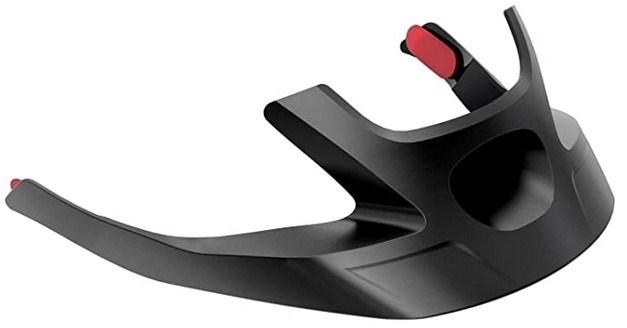As you shop for a bike helmet, you will notice that some have visors while others don’t. It is requisite to understand both options to know what suits you. Now, ask yourself: Do I Need A Visor On My Bike Helmet?
Visors are essential for off-road biking to protect you from sun glare, debris, branches, spider webs, and weather elements from hitting your face and eyes. In contrast, they aren’t necessary for road biking because they slow you down and block your vision.
The choice between a bike helmet with a visor and one without is dependent upon where you want to cruise down the road or street or handle the rougher mountain terrain. Let’s explore this further.

Why Do Bike Helmets Have Visors? (5 Reasons)
Bike helmets have visors because they protect the rider from potential hazards when riding off-road. Biking on rough terrain presents different obstacles that can harm or ruin your riding experience, including tree branches, gravel, mud, snow, and sunlight.
You need to use a bike helmet visor if you are an avid off-road biker as you will encounter many things that might harm your eyes and face.
Let’s look at instances where having a visor is crucial.
1. Riding In The Sun
If you have ever ridden your bike on a mountain immediately before sunset or when the sun is rising, you know the struggle of keeping the glaring sun out of your eyes. Without proper protection, the sun will be shining directly at your eyes because they are at a similar level at these times.
Sunlight blocks your view, making it hard to stay on the trail. A visor blocks the sun and the heat allowing you to drive more comfortably and even go directly towards the sun and stay balanced on your bike.
2. Riding In Areas With Frequent Sunlight And Shade Transitions
The sudden change from shadow/shade to sunlight can be blinding if you ride without a visor. Visors also come in handy when cycling in an area with transitions between shade and sunlight.
A bike helmet visor helps you handle the sudden transitions better and stay upright on your bicycle. Therefore, a visor is a crucial accessory if you plan to ride in these conditions.
3. To Keep Away Low Hanging Tree Branches
Without a visor, you have to use one of your arms to keep tree branches away when riding on narrow hilly trails and bushy terrains. This will likely make you lose control of your bike, causing a crash.
A visor helps keep away these obstacles allowing you to focus on the trail and balancing your bike.
4. Riding In Tough Weather Conditions
Mountain bikers love a challenge, and so they look for new adventures, more challenging trails, and even riding in adverse weather conditions like snow, mud, and heavy rain. However, remember that cycling in bad weather can be unbearable, so make sure you are fully prepared.
For instance, rain, mud, and snow can get into your eyes, obstructing your vision. In addition, snow and rain can damage your scalp if exposed to these elements for a prolonged time.
A bike helmet visor will help protect your eyes and head from various weather elements. Since visors stretch out on the front, they offer protection for your eyes from windy rain and snowdrops.
Your vision will remain clear when wearing a helmet with a visor; hence you will go faster and also see the trail ahead clearly.
5. When You Don’t Want To Wear Sunglasses
Some bikers pair their bike helmet visors with sunglasses, while others choose between them. You can decide not to wear sunglasses when wearing a helmet with a visor.

Should I Get A Bike Helmet With A Visor? Explained For Beginners
The decision to get a bike helmet that has a visor is ultimately yours because some riding styles call for the use of visors more than others. Visors are better suited for off-road bikers rather than on-road bikers because they face more obstacles.
To help you make the right decision, let’s take a look at the pros and cons of visors in mountain biking and road biking.
1. Road Biking
You won’t see many road bikers using visors because these accessories present more drawbacks than strengths for road biking.
While a visor blocks the sun and other elements from hurting you and prevents sunburns, it makes you less aerodynamic because it traps the air and functions as a sail, slowing your bike down.
You want to be sleek, nimble, and light when riding a roadie. A visor adds weight, making you feel bulky in the head and even lower your speed.
In addition, having a clear vision is critical while on the road. You should be able to turn your head to look at what is behind you or beside you, but visors block your vision, rendering road navigation challenging.
While some road bikers use visors because they do not mind riding slower, the bulkiness, and enjoy the advantage of blocking the sun, visors aren’t ideal for road cycling.
Your safety comes first, so before using a visor on the road, think about the ramifications of a compromised field of vision.
2. Mountain Biking
You should absolutely get a visor if you are a mountain biker because it will provide the protection you require against weather elements (rain, snow, wind, etc.).
It also shields your face from hanging branches, splashing mud, gravel, and keeps your face and eyes hidden from the sun.
Although crushing is part of mountain biking, you don’t want to hurt your face, nose, and teeth when you go down. A visor will absorb the impact of a fall and ensures your face doesn’t hit the ground first.
However, visors can snag a tree branch sometimes, which is annoying and interferes with your riding.
You will look like a pro wearing a bike helmet with a visor when mountain biking but out of place when road biking.
Can You Add A Visor To A Bike Helmet? (Quick Answer)
You can attach a detachable visor to your existing bike helmet if it doesn’t have a built-in visor and enjoy its benefits in a cost-efficient manner.
Detachable visors are sold separately from bike helmets, so you can quickly get yourself one and install it on your helmet.
An excellent example of a high-quality visor to consider is the Sena Visor R1 Series. It is ideal for medium and small R1 helmets, easy to attach and detach, and offers exceptional protection.

Go for a versatile visor if you own different types of helmets to ensure you are shielded. Make sure it also provides proper airflow so that you stay calm and comfortable when pedaling.
FAQs
1. Can I Wear A Visor With A Bike Helmet?
You can wear a visor with your bike helmet if you want protection against obstacles and keep the blinding sun away. Visors are prevalently used among mountain bikers, but some road bikers who aren’t keen on riding fast wear them.
2. Are Visor Helmet Good?
A good quality visor that is shatter-resistant offers the protection you need when biking on a rough trail. Ensure your visor is extended properly without impeding your eyesight.
3. What Is Visor For On MTB Helmet?
Visors on MTB helmets protect the rider’s eyes and face by deflecting dirt, snow, tall branches and brushes, gravel, rain, and sunlight. With a visor, your face will stay drier when riding in the rain.
4. Why Do Some Bike Helmets Have Visors?
Some bike helmets, such as mountain bike helmets, have visors because riders need to protect their eyes and faces from the harsh conditions of rougher terrains.
Without visors, dirt, snow, mud, and rain will get into your eyes, and the sun will compromise your vision and give you sunburns, while trees will poke you.
5. Why Do Road Helmets Not Have Visors?
Road bike helmets don’t have visors because they put you in danger of accidents by obstructing your vision field. It also counteracts the core purpose of road riding- speed by creating drag, which slows you down.
6. How Do You Put A Visor On A Bike Helmet?
Use Velcro or push buttons to attach a detachable visor to a bike helmet. You get proper shielding and the choice of removing the visor when you don’t need it.
7. Can You Take The Visor Off A Bike Helmet?
You can remove a detachable visor from your bike helmet by pulling the tiny push buttons or the Velcro used to hold it in place. You don’t have to use your visor all the time, so detaching it offers the convenience of using the same visor on different helmets.
Overall, you can attach the visor when you go mountain biking and detach it when you want to take a ride to the shopping center, within your neighborhood, or road race with your friends.
In Conclusion, Do I Need A Visor On My Bike Helmet?
As mentioned earlier, your riding style and preference dictate whether you need a bike helmet visor. This simple bike gear can elevate your riding experience as it keeps your face and eyes safe.
Whether you use a visor or not, make a conscious decision of putting on your helmet for your wellbeing.
Also, read: How Often Should You Replace Your Bike Helmet?